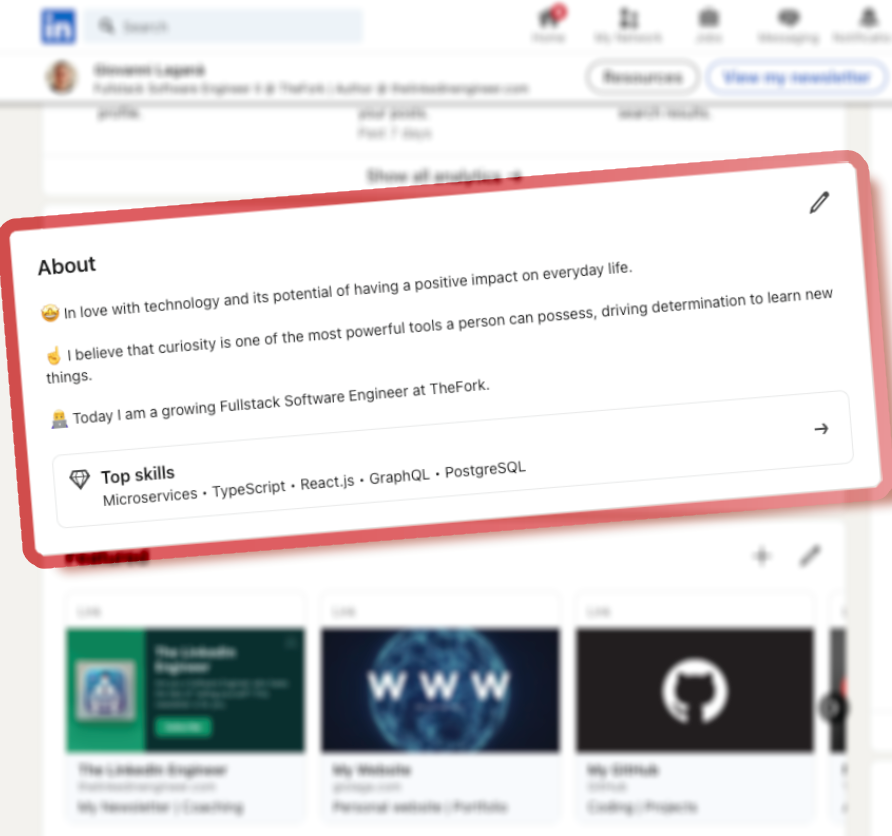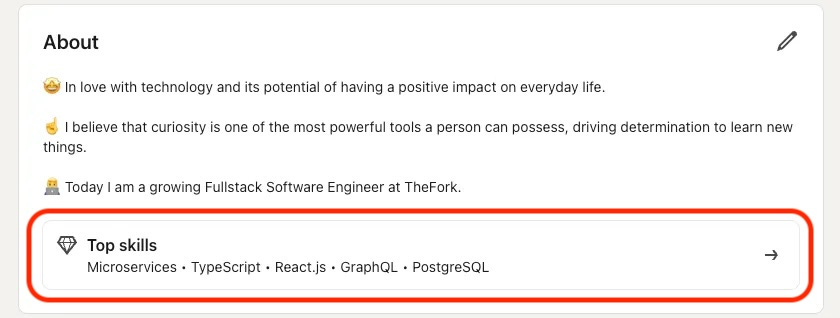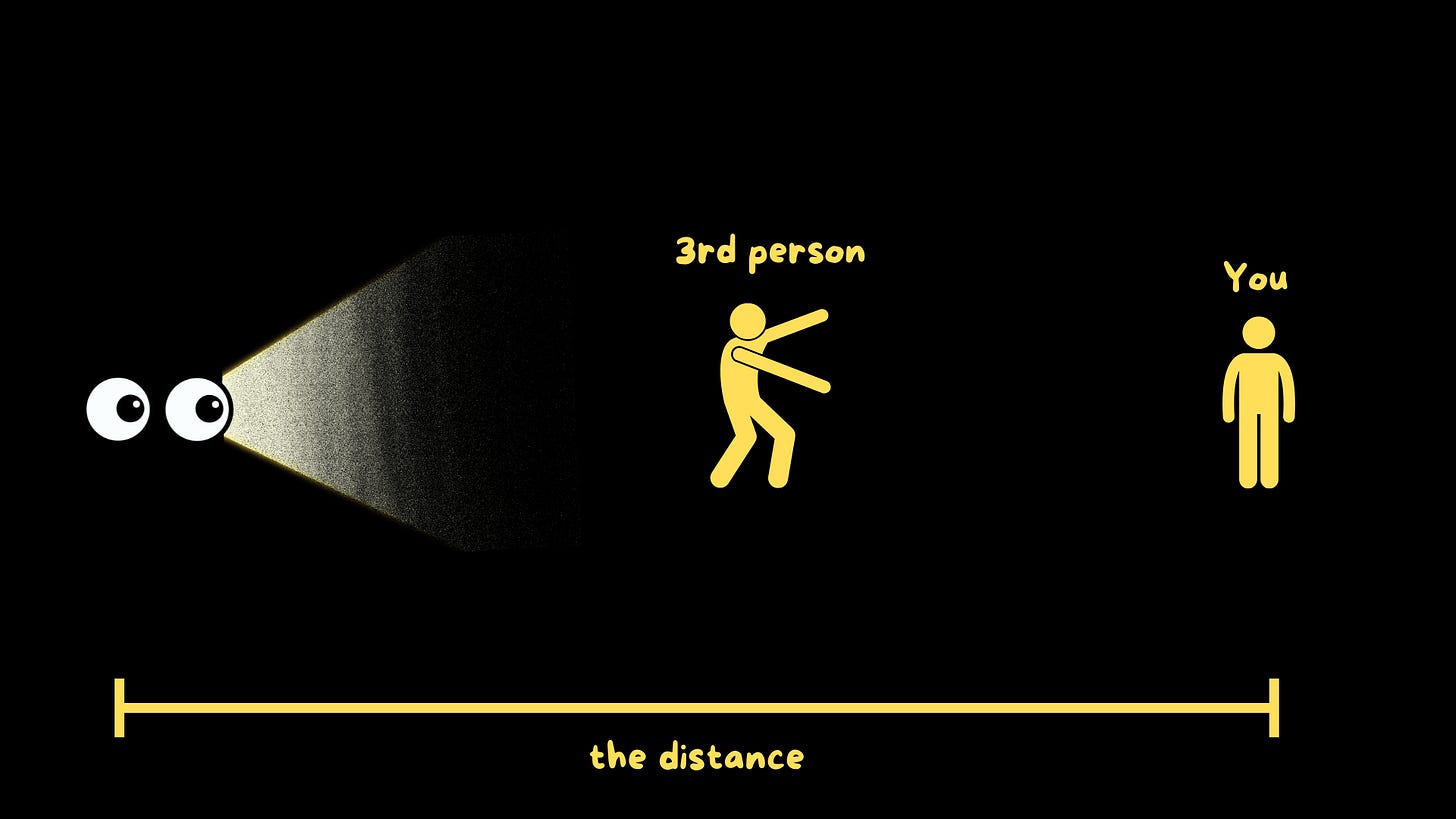The "About" section ✨
7 golden rules to make it captivating
One of the most abused sections on LinkedIn is the “About” section.
This space should be dedicated to giving the reader a description of who you are.
At the time I am writing this, LinkedIn has also decided to include the “Top skills” inside it, highlighting up to 5 skills.
After trying tons of different variants, I’d like to share with you my 7 golden rules to have an effective description:
1. Be short
In a world with a dramatic decrease for the attention threshold, you can’t afford to write a wall of text, or do a full biography. Think about what you need to say, and reformulate it multiple times until you compress it as much as possible.
Recruiters seem to spend, on average, 7.4 seconds on resumes (source), we can imagine a similar time is spent on LinkedIn.
2. Use strategic emojis
In order to be really communicative or describe a feeling, you typically need more words to describe it properly. Placing emojis in the right place, and without exaggerating, can be an incredible trick to compress the meaning even more and save space.
Need an example?
”I design and develop scalable applications, writing clean code and collaborating with teams to build great products.”
vs
“I design & build scalable apps 🏗️, write clean code 🧑💻, and collaborate 🤝 to create great products.”
3. Choose skills carefully
45% of recruiters on LinkedIn use skills data to identify candidates for open positions (statistics).
You better choose your Top skills carefully!
💡 Tip: remember that skills are the same entities used to accompany your items inside the “Experience” and “Projects” section. The most lethal combo is if you manage to spot 5 skills and continuously repeat them among these sections. Having them in your “About” section and then seeing them again in the others will reinforce the idea that you are proficient in those areas.
4. Avoid the “Wikipedia page” effect
Remember I mentioned that in my post about the tone of voice?
(If you don’t, you find it here 👇🏻)
This is one of those sections where people typically talk about themselves in the third person.
Please. Don’t do that.
As always, keep in mind that the visitor is one person, and you are talking to that person directly.
❌ Giovanni is a Software Engineer with 4 years of experience
This gives the perception that you have a ghostwriter preparing the profile for you, and this is what you create inadvertently:
you clearly see that you create a useless distance between you and the visitor.
✅ I am Software Engineer with 4 years of experience
Talk in the 1st person, and you will shorten the distance
5. Not a summary, and not a biography.
The typical mistake I see people making is treating this section either as a summary of the rest of the profile or as a biography.
The reason why you don’t want to do that is that you are basically creating useless redundancy.
Your name, your years of experience, your skills, your story… all of that is info that the visitor can easily find in other sections. Don’t mix the purpose of each section. Take advantage of this one to say something more about you.
💡 Tip: think about this section as a spotlight on what you represent, as an individual, in the Software Industry. You can also add your personal thoughts, claims, or even ambitions for your career.
6. If it’s tough, split it in 3
A little trick I use for this section is splitting it into 3 parts:
Why I am a Software Engineer:
🤩 In love with technology and its potential of having a positive impact on everyday life.What drives me to grow:
☝️ I believe that curiosity is one of the most powerful tools a person can possess, driving determination to learn new things.Who I have become at the moment:
👨💻 Today I am a growing Fullstack Software Engineer at TheFork.
I encourage you to find your schema, but why I think this one works?
→ you see my face, and the headline (you start empathizing with me)
→ you read my claim (you get curious)
→ you discover what fuels me in my profession (you get engaged)
→ you see confirmation of the preview, and you get ready for the rest of the profile
7. Be inspirational
This is the section where you really have the chance to transmit your personality. It’s a complete waste to write like a robot while describing yourself.
Are you passionate about Software Engineering? Do you have entrepreneurial ideas? Do you have the ambition to build something? Or to become someone?
Just tell it! This is literally your calling card, and you have to inspire others.
If you inspire people, they will get excited about reading about you.






